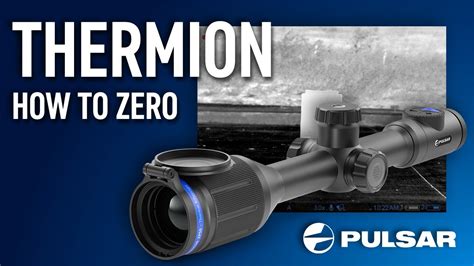How To Sight In A Pulsar Thermal Scope
Ronan Farrow
Apr 02, 2025 · 3 min read

Table of Contents
How to Sight in a Pulsar Thermal Scope
Thermal scopes, like those from Pulsar, offer unparalleled hunting and observation capabilities, even in complete darkness. However, before you can harness their power, you need to properly sight them in. This process ensures your shots are accurate and consistent, maximizing the effectiveness of your thermal imaging device. This guide will walk you through the steps of sighting in your Pulsar thermal scope, highlighting crucial considerations for optimal performance.
Understanding the Basics of Thermal Scope Sighting
Before we dive into the process, it's essential to grasp the fundamentals. Sighting in a thermal scope involves adjusting the internal reticule (crosshairs) to align perfectly with your point of impact (POI) at various ranges. This requires patience and precision, as even slight misalignments can significantly affect accuracy.
Key Components to Consider:
- Zeroing Distance: Choose a distance that's suitable for your intended use. Common zeroing distances include 25, 50, or 100 yards (or meters).
- Ammunition: Use the same ammunition type you intend to use during hunting or observation. Variations in ammunition can affect trajectory and point of impact.
- Stable Rest: A sturdy shooting rest, such as a bench rest or shooting bag, is crucial for accurate zeroing. Any movement during the sighting process can lead to inaccurate adjustments.
- Target: Use a clear, well-defined target at your chosen zeroing distance.
Step-by-Step Guide to Sighting in Your Pulsar Thermal Scope
This detailed guide will help you efficiently and accurately sight in your Pulsar thermal scope. Remember, safety should always be your top priority when handling firearms.
Step 1: Preparation is Key
- Ensure Safety: Always follow firearm safety rules. Handle your weapon responsibly, treat every firearm as if it were loaded, and keep your finger off the trigger until ready to shoot.
- Secure Your Setup: Position your rifle on a stable rest at your chosen zeroing distance, ensuring it's firmly supported and won't move during the process. Set up your target at the same distance.
- Familiarize Yourself with the Controls: Understand your Pulsar thermal scope's adjustment knobs. Most Pulsar scopes offer clear markings indicating windage (left/right) and elevation (up/down) adjustments. Note the click values—how many clicks equal one inch or centimeter of adjustment at your zeroing distance. Consult your scope's manual if unsure.
Step 2: Initial Zeroing
- Initial Shot Group: Fire a three-shot group at your target. Observe the point of impact relative to your scope's reticle.
- Adjustments: Based on the shot group, make the necessary windage and elevation adjustments using the scope's adjustment knobs. Remember to adjust one axis at a time to avoid confusion and ensure precise adjustments. Each click is a precise amount of adjustment, so avoid overcorrection.
- Repeat: Fire another three-shot group to verify your adjustments. Repeat this process until your POI is centered on your reticle.
Step 3: Fine-Tuning and Verification
- Refinement: Once your group is centered, fire a few more shots to confirm the accuracy of your zero. Make subtle adjustments if needed to achieve perfect center impact.
- Distance Verification: If using the scope at multiple distances, repeat the entire process at each distance. Most Pulsar scopes are parallax-free, but re-zeroing at various ranges ensures optimal accuracy at each point.
- Documentation: Note the exact settings for both windage and elevation. This will be invaluable if you ever need to re-zero your scope or troubleshoot issues.
Troubleshooting and Tips
- Consistent Groups: If your shot groups are widely scattered, check for issues like loose mounts, ammunition inconsistencies, or improper shooting technique.
- Manual Review: Always consult your Pulsar thermal scope's user manual for specific instructions and adjustments relating to your model.
- Professional Assistance: If you're struggling with the sighting-in process, consider seeking assistance from a professional gunsmith or experienced shooter.
By following these steps and taking your time, you'll be able to successfully sight in your Pulsar thermal scope, unlocking its full potential for accurate and effective performance. Remember to always prioritize safety and practice responsible firearm handling.
Featured Posts
Also read the following articles
| Article Title | Date |
|---|---|
| How To Tell If A Golf Cart Is Charging | Apr 02, 2025 |
| How To Register A Boat In Idaho | Apr 02, 2025 |
| How To Sun Dry Cherry Tomatoes | Apr 02, 2025 |
| How To Replace Bunk Carpet On A Boat Trailer | Apr 02, 2025 |
| How To Quiet Rv Ac | Apr 02, 2025 |
Latest Posts
-
How Does Pay As You Go Electricity Work
Apr 04, 2025
-
How Does Our Garden Grow
Apr 04, 2025
-
How Does One Dark Window End
Apr 04, 2025
-
How Does No Shave November Work
Apr 04, 2025
-
How Does Night At The Races Work
Apr 04, 2025
Thank you for visiting our website which covers about How To Sight In A Pulsar Thermal Scope . We hope the information provided has been useful to you. Feel free to contact us if you have any questions or need further assistance. See you next time and don't miss to bookmark.
